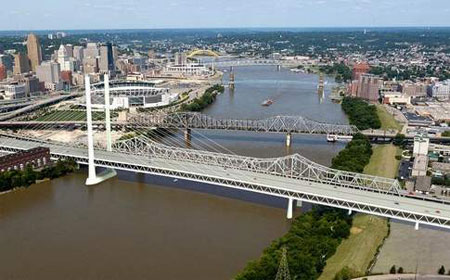It is once in a great while that you have a multi-billion infrastructure project like the
Brent Spence Bridge replacement - it is even more rare when you have three multi-billion infrastructure projects that will completely reconfigure I-75 virtually from the north end of the I-275 beltway to the south.
The Brent Spence Bridge project represents a mere 8-mile stretch of the larger reconfiguration plans, but also represents a $2 to $3 billion cost according to
Ohio, Kentucky, Indiana (OKI) Regional Council of Governments spokesperson Brian Cunningham.

"This is the number one priority for our region because the Brent Spence Bridge is a safety hazard and a major choke point for two interstates," said Cunningham.
The safety concerns include confusing and poor signage that leads to dangerous "weaving and merging" on a narrow bridge that includes no break down lanes.
"OKI has estimated that there is a crash along this 8-mile stretch once every three days, and when a crash occurs on that bridge it basically shuts down two interstates," explained Cunningham.
Design alternatives have been publicized recently by the team of engineers from
Parsons Brinckerhoff working on the project. The designs of the bridge itself, and the overall engineering of the 8-mile stretch have been met with a number of concerns ranging from environmental impact to the aesthetic design of the bridge itself, to interstate access for communities within the corridor.
To the OKI Regional Council of Governments, Cincinnati's Metropolitan Planning Organization, who is in part charged with allocating federal transportation dollars, the focus is clear.
"A recent study indicated that $400 billion worth of commodities travels across that bridge every year; a number that will grow to $815 billion by 2030," said Cunningham. "This is the center point for our region's multi-modal transportation network."
Engineering studies have shown that the
Brent Spence Bridge has anywhere from 40 to 60 years worth of functional life left, but the congestion and safety concerns posed by the current system is something that has local and regional leaders concerned that if action is not taken soon, the region will suffer significant negative impacts.
"This will have an astronomical impact not only on the local level, but on a regional and national level as well," said Cunningham. "Our local leaders have been very supportive and have worked hard for this project which is a real plus when engaging in a $2 to $3 billion project."
Writer:
Randy A. SimesRendering ProvidedStay connected by following Randy on Twitter
@UrbanCincy
Enjoy this story?
Sign up for free solutions-based reporting in your inbox each week.